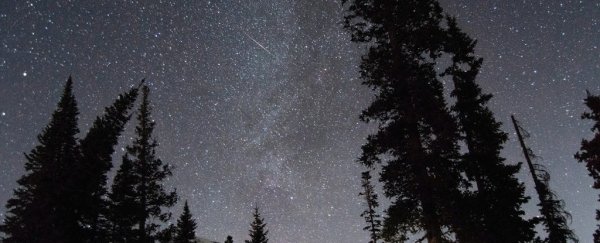Stuck at home with clear skies? We're all in a similar situation, as the ongoing pandemic sees most of the worldwide amateur astronomy community observing from home or from their backyard.
One astronomical sure-fire event coming up this week requires no special equipment, just a set of working 'Mk-1 eyeballs' and a clear sky: the April Lyrids.
These springtime meteors get their name from the constellation Lyra, which also hosts the bright star Vega. The parallelogram shape of Lyra marks out the Lyre of Orpheus from Greek mythology, the musical instrument that the virtuoso played at the gates of Hades in an ill-fated attempt to win back Eurydice from the Underworld.
Perhaps, we can imagine the Lyrids as the 'Tears of Orpheus,' sliding silently through the April sky.
The curious history of the Lyrids
The April Lyrids are one of the oldest meteor showers recorded. Chinese historical records note that in the fourth month of 687 BC, "stars fell like rain".
The Lyrids were identified as a modern shower by Johann Gottfried Galle in 1867. The source of the April Lyrid meteors is comet C/1861 G1 Thatcher, which orbits the Sun every 415 years and is projected to return around 2280 AD.
Prospects for 2020
The Lyrids are a modest shower on most years, but are prone to occasional outbursts, most notably in 1803, 1922 and 1982, when rates topped 250 an hour.
In 1803, a Richmond Virginia journalist noted "shooting stars… from one until three in the morning (that) seemed to fall from every point in the heavens…" Clearly, the Lyrids harbor some intense storm clumps, that seem to show up every 60 years or so. Perhaps we'll see an uptick in activity come 'round 2040?
The Lyrids have a steep approach to the Earth, with a radiant declination located in the northern hemisphere at +32 degrees north. Their oncoming medium to swift velocity is 48 kilometers per second, fast as meteor showers go, about 25 percent of Lyrid meteors are fireballs leaving persistent trains, worth keeping binoculars handy for.
2020 is an ideal year for the Lyrids. The peak arrives on the morning of Wednesday, 22 April at just past midnight Universal Time (UT, on the night of April 21/22), favoring Europe and the Middle East near dawn.
 (Dave Dickinson/Orbitron)
(Dave Dickinson/Orbitron)
The Moon is out of the scene, and reaches New just 24 hours after the shower's peak.
The peak Zenithal Hourly Rate for the 2020 Lyrids is projected to top 20 meteors per hour. Keep in mind that the ZHR is an ideal maximum, what you would expect to see if the radiant is directly overhead under pristine dark skies. Most observers will see considerably less.
Observing Lyrids
Watching a meteor shower is as simple as observing the sky with the naked eye and waiting… no special equipment needed. Meteors can appear anywhere in the sky, but a good rule of thumb is to actually look off to either side of the shower radiant, to catch the meteors in profile.
Any Lyrids will trace their path through the sky back from the radiant in the constellation Lyra. Any that do not belong to other showers, or are sporadics.
Morning around pre-dawn is always the best time to watch for meteors, as your location on the Earth is turned headlong into the oncoming meteor stream.
You can count how many Lyrids you see from your location and report the tally for the given span of time back to the International Meteor Organization. This is one way that amateur astronomers can contribute to our scientific understanding of meteor showers and the evolution of meteor streams.
 Our humble DSLR camera rig. (Dave Dickinson)
Our humble DSLR camera rig. (Dave Dickinson)
Photographing meteors is also a pretty straightforward process: simply set up a DSLR camera with a wide-angle lens, and take time exposure shots of about 30 seconds to a minute in duration and see what turns up.
I like to automate the process with an intervalometer, that way, I can just kick back and watch the sky while the camera clicks away. Be sure to start with fresh batteries, and take several preliminary shots to get the correct balance of exposure vs. f-stop and ISO for current sky conditions.
Though the Lyrids are the sole major shower of Spring, there are several other meteor showers to look forward to in 2020, including the Perseids (August 12th) and the Geminids (December 14th).
One thing is certain when it comes to meteor showers: you won't see any if you don't try. If skies are clear, be sure to watch for the Lyrid meteors over the next few mornings.
This article was originally published by Universe Today. Read the original article.
